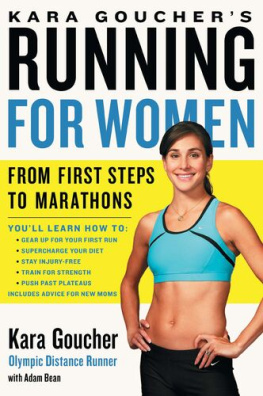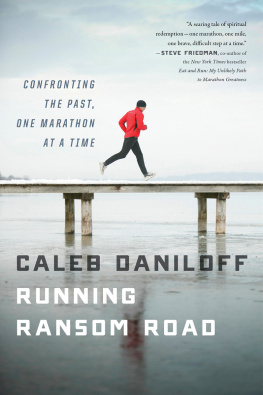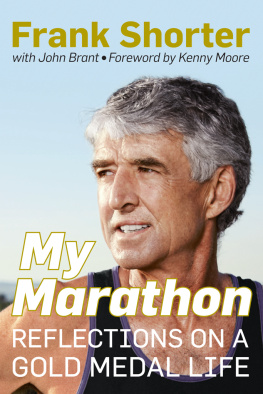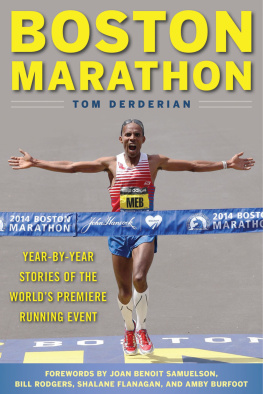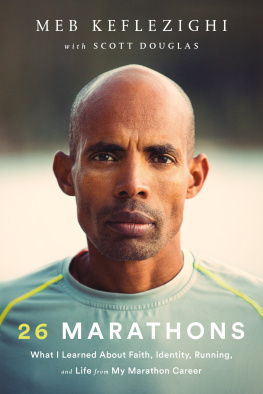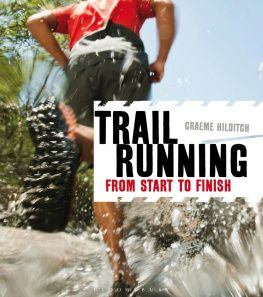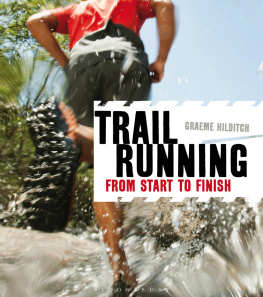For information about permission to reproduce selections from this book, write to Permissions, Houghton Mifflin Harcourt Publishing Company, 215 Park Avenue South, New York, New York 10003.
Library of Congress Cataloging-in-Publication Data is available.
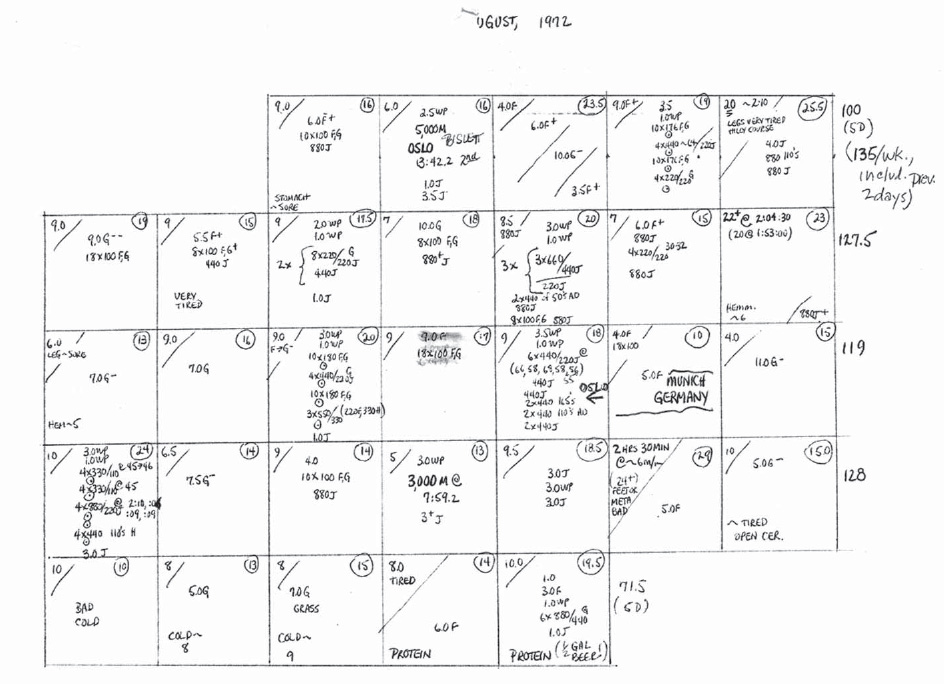
Training log kept by Jack Bacheler of his workouts with Frank Shorter in the month before the Munich Olympics.
Courtesy Jack Bacheler
Preface
The race is not to the swift. It is, instead, to the resolute and implacable, the steadfast, unswerving, and devoted. Any fool can dash down a straightaway and collapse in a heap. But to continue when every nerve in the body is screaming to stop, to push past fatigue, exhaustion, and despair, to ignore reason and embrace the irrational. That is true greatness. The mark of a champion.
During the decade from 1972 to 1982, three American men became world champions in the sport of distance running. They rose from obscurity and raced their way into the countrys hearts and minds. Their victories were celebrated on the front pages of newspapers, heralded on magazine covers, and trumpeted by television commentators. They became household names, and their accomplishments spurred millions to join them. In their footsteps, running boomed, and an industry worth billions was born.
Frank Shorter, Bill Rodgers, and Alberto Salazar did not set out to be heroes for a generation weary of war and unrest. Each wanted, simply, to be the best in the world. They overcame barriers erected by others and proved to themselves they had the strength, willpower, and leg speed to win. Not for fame or fortune amateur rules at the time prohibited them from earning a dime but for the pure love of the sport.
Shorter was the trailblazer, the doctors son from Connecticut who dropped out of medical school to pursue his dream. Yale educated, raised in upper-middle-class comfort, he harbored a dark family secret that pushed him to run harder, faster, and farther in a futile effort to keep it at bay. Self-coached, he experimented with training at altitude and on the track, running 440-yard intervals with a milers precision. He was fiercely loyal to friends such as Steve Prefontaine, but he also could be aloof and secretive, and he wasnt beyond playing mind games with his competitors before or during a big race. His breakthrough at the Munich Olympics would light the torch for everything that followed.
Bill Rodgers, his contemporary, graduated from Wesleyan University and wandered aimlessly astride his motorcycle with a pack of cigarettes in the last years of the Vietnam War. A conscientious objector, he returned to running because it was all he had left during those dark and empty days. He survived on food stamps, while he ran hundreds of laps indoors on an old wooden track when it was too cold to run outside in the Boston winter. The Greater Boston Track Club would provide him with teammates and a home, and with them he put together a life that exploded into public view one Monday in April.
Alberto Salazar was the Rookie, the high school phenomenon who trained with Rodgers as a skinny, awkward sixteen-year-old. His father had fought beside Fidel Castro and Che Guevara in the Cuban Revolution, then fled to the United States when Castro turned Cuba into a godless republic. The boy inherited his fathers hotheadedness and ran both to please the man and to escape him. Nothing stopped him: not fatigue, heat, or even death. He was determined to be the world record holder before his twenty-second birthday.
Each runner discovered his ability in an almost accidental way, and each progressed on a path without clear guideposts. There was no organized state program to develop their promise, no nutritionists and trainers to monitor their every twitch, no corporate interests to underwrite their training. They ran because they had to, transforming the sport in the United States and dominating the world for most of a decade.
Since that time, no American man has attained their level of achievement, and only Joan Benoit Samuelson (during roughly the same time period) achieved their name recognition. Indeed, since their heyday, no U.S. runner (with the exception of Samuelson in 1984 and Bruce Bickford in 1985) has won a gold medal in any Olympic event or been ranked first in the world at any distance longer than 400 meters.
Was it something in the air? Something in the water? Some magic pixie dust that turned the United States from a country of pot-smoking hippies to a nation of fleet-footed runners? Suddenly, skinny guys were cool, and LSD was an acronym for long slow distance. Grown men appeared on the roads in their long underwear and gloves, battling traffic for the shoulder. Swooshes and stripes became tribal commitments, while gel, goo, and goop became breakfast.
Their deeds, however, might have been doomed to oblivion, vanished in the margins of Obscure Sports Quarterly, except for one thing: they had one another. In that gloomy decade, they came to prominence in the glow of one anothers achievements. Shorter-Rodgers- Salazar. Trailblazer-Popularizer-Usurper. Brains-Soul-Heart. Their competition made them train harder, race faster, strategize better. By themselves, they might have simply won races; together, they changed everything.
The marathon would establish them, and the track would distinguish them, but it was on the roads at the non-marathon distances where they made their greatest impression. The road race was the prime showcase for their prolific talents. The track was too specialized and the marathon too intimidating, but a road race was something the average person could love. An untrained novice could toe the line with the best in the world, standing shoulder to shoulder until the gun went off. He could jump into a five-mile race on a Saturday morning and still have plenty of time for breakfast and a nap. It was a peoples event led by world-class athletes, the perfect venue for the children of the revolution who had turned inward to self-improvement. Yet in an increasingly complex and confusing world, running was also a commitment to something larger than the self: the road race as collective achievement, where everyone was a winner. Shorter, Rodgers, and Salazar led the way, and in their wake a thousand races bloomed.
Of all the races born during this decade, one stood apart. One race ruled them all. It began as a small midweek jaunt in a nondescript Cape Cod town, organized as an excuse to go barhopping, and it blossomed into an international sporting event, drawing the elite to its starting line. It became the proving ground for everyone who was anyone and quickly gained the reputation as the best road race in the United States. In the course of ten years, Shorter, Rodgers, and Salazar dominated, winning seven times, setting seven course records, and making the town their home.
The Falmouth Road Race was the perfect metaphor for the running boom. It was birthed by Shorter, nurtured by Rodgers, and reached its apogee with Salazar. It was also the first, last, and only race where the three men competed head-to-head. The story of Falmouth is the story of running during its golden age, its rise and growth mirroring Americas love affair with the sport. It is also a story about the United States at a time when one moment was ending and another beginning. In the depths of a spiritual and economic crisis, a renaissance was stirring in the cities, in the arts, in business and finance. Running was both a symptom of Sisyphean despair and the antidote to discontent and torpor. One foot in front of the other, a meaningless activity, and yet the most profound. Falmouth was the measure of a runners conviction and the place to which he returned, to race against others and himself.




